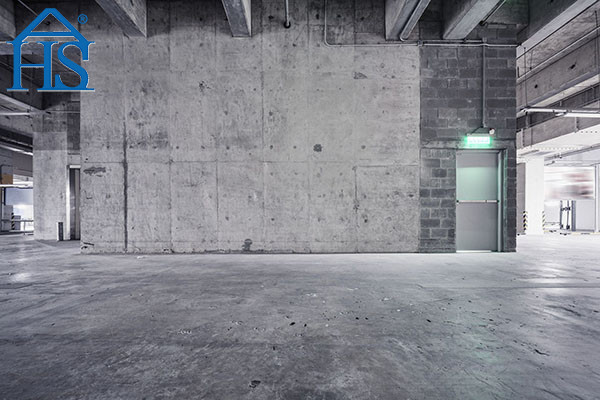Beton yüzeyin gevşek yapısının ve düşük mukavemetinin iki ana nedeni vardır.:
1) Beton yüzeyinin su-çimento oranı betonun iç kısmından daha büyüktür, ve yüzeyin hidrasyon ürünleri arasındaki bağın yoğun olmaması, ve boşluk oranı büyüktür;
2) Betonun uygunsuz kürlenmesinden dolayı inşaatın erken safhasındaki su kaybı çok hızlıdır., çok sayıda su deliği oluşturmak, ve yüzeydeki çimento hidratasyon için yeterli suyu alamıyor.
Beton yüzeyindeki çimentonun hidratasyon derecesinin test edilmesi, “Tozlanmanın” nedeninin belirlenmesine yardımcı olabilir..
Yüzey çimentosunun yüksek hidrasyon derecesi esas olarak kanamadan kaynaklanır., ve düşük yüzey hidrasyonu temel olarak uygunsuz inşaat ve bakımdan kaynaklanmaktadır..
Beton yüzeyinin su-çimento oranına etki eden faktörler
Betonun karışım oranı
- Betonun su-çimento oranı ne kadar büyük olursa, Çimentonun priz alma ve sertleşme süresi ne kadar uzun olursa. Daha fazla serbest su, ve su ile çimento arasındaki ayrılma süresi ne kadar uzun olursa, beton ne kadar kolay akarsa.
- Betona aşırı katkı veya geciktirici eklenmesi, taze betonun büyük miktarda kanamasına ve çökelmesine neden olur., beton yüzeyinden dışarı sızan büyük miktarda serbest su, Çimento prizini ve sertleşmesini etkileyen, ve betonun su tutma performansının azaltılması, ciddi su kanamasına neden olur.
Betonun bileşen malzemeleri
- Kum ve çakıl agregası büyük miktarda çamur içerdiğinde, çimentonun erken hidratasyonunu ciddi şekilde etkileyecektir, ve kildeki yapışkan parçacıklar çimento parçacıklarını saracak, Çimento hidratasyonunu ve beton prizini geciktirir ve engeller, Böylece betonun su salgısı yoğunlaşır.
- Kumun incelik modülü ne kadar büyük olursa, kum ne kadar kabaysa, hangisinin beton kanamasına neden olma olasılığı daha yüksektir. Özellikle, 0,315 mm'nin altındaki ve 2,5 mm'nin üzerindeki parçacıkların içeriği kanama üzerinde daha büyük bir etkiye sahiptir: ince parçacıklar ne kadar azsa, daha kaba parçacıklar var, ve pıhtılaşmanın kanama olasılığı daha yüksektir.
- Mineral katkıların parçacık dağılımı da betonun kanama performansını etkiler.. Mineral katkıların daha az ince parçacık ve daha fazla kaba parçacık içermesi durumunda, betonun kanamasına neden olmak kolaydır. Katkı maddesi olarak öğütülmüş cüruf kullanıldığında, Karışım oranındaki çimento içeriğinin azalması nedeniyle cürufun hidratasyon hızı yavaştır, ve cüruf camının su tutma performansı zayıftır, bu da genellikle betonun kanamasını artırır.
- Uçucu kül çok kaba ise, ince agrega etkisi zayıflayacak, bu da beton kanamasını artıracak.
- Ayarlama süresi, incelik, Çimento spesifik yüzey alanı ve partikül dağılımı betonun kanama performansını etkileyecektir.. Çimentonun priz süresi ne kadar uzun olursa, Hazırlanan betonun priz süresi ne kadar uzun olursa, ve priz süresi çimento hamurundan ne kadar uzun olursa. Betonun dikilmesi, sertleşmesi ve sertleşmesinden önce, çimento parçacıklarının yerleşme süresi ne kadar uzun olursa, betonun kanaması daha kolay; Çimentonun inceliği ne kadar kaba olursa, spesifik yüzey alanı ne kadar küçükse, ince parçacıkların içeriği ne kadar azsa (<5a) parçacık dağılımında, Erken çimentonun hidratasyon miktarı ne kadar az olursa, ve daha az hidratasyon ürünleri betondaki kılcal gözenekleri tıkamak için yeterli değildir., iç nemin aşağıdan yukarıya doğru kolayca hareket etmesine ve daha ciddi beton kanamasına neden olur.
İnşaat ve bakım
- İnşaat sırasındaki aşırı titreşim, betondaki yoğunluğu daha küçük olan katkı veya karışımı beton yüzeyine titreştirmez., ancak betonun kanamasını yoğunlaştırarak beton yüzeyinin su-çimento oranını arttırır..
- Beton yüzey tabakasındaki çimentonun kür için sulanmadan önce sertleşmemesi veya yüzeyin yağmur suyuyla ovalanması durumunda da beton yüzey tabakasının su-çimento oranı artacaktır..
- Betonun inşaatı ve bakımı sürecinde, Beton güneşe veya kuru havaya maruz kaldığında, Yüzeydeki nemin buharlaşması betonun kanama oranından daha fazladır, bu da yüzey neminin büyük miktarda buharlaşmasına yol açacaktır, yüzey çimentosunun yetersiz hidrasyonu, ve yetersiz yüzey kuvveti, Tozlanma ile sonuçlanan.
Öyleyse, inşaat ve bakım yöntemleri farklı iklim koşullarına göre ayarlanmalıdır., Yeterli dayanım sağlanana kadar inşaat sonrasında betonun şiddetli su tutma olmaksızın yeterli ıslak bakıma sahip olmasını sağlamak için farklı dayanım derecelerindeki beton ve farklı çimento türlerini zamanında kullanın.
Beton yüzeyde tozlanma nasıl önlenir??
- Ciddi kanama nedeniyle beton yüzey tabakasının aşırı su-çimento oranının önlenmesi için betonun kendisi iyi bir su tutma özelliğine sahip olacaktır.. Karışım oranının ve bileşim malzemelerinin seçiminden başlayarak, Su-çimento oranının çok büyük olmamasına dikkat edilecektir., katkının çok karıştırılmaması ve priz süresinin uygun olması. Agrega ulusal kalite gerekliliklerini karşılayacaktır, özellikle kumdaki 0,315 mm'nin altındaki parçacık içeriği. Çimentonun priz süresi çok uzun olmamalıdır, spesifik yüzey alanı çok küçük olmamalıdır, ve parçacık derecelendirmesi çok konsantre olmamalıdır.
- İnşaat sırasında betonda aşırı titreşimden kaynaklanan ciddi ayrışma ve kanama önlenecektir..
- İnşaattan sonra zamanında kürlenmeye dikkat edilecektir., beton yüzeyi sertleşmeden önce yağmur suyunun neden olduğu beton yüzeyindeki aşırı su-çimento oranının önlenmesi için değil, aynı zamanda yüzey tabakasının mukavemeti oluşmadan betondaki su kaybını önlemek için. Özellikle uçucu kül veya cürufla karıştırılmış beton için, Erken mukavemetinin düşük olması nedeniyle, yüzey katmanındaki büyük gözenekleri tıkamaya yetecek kadar hidrasyon ürünü yok, If sufficient wet curing is not paid attention to in the early stage, the water loss of the concrete surface layer is relatively fast, and the surface cement is not fully hydrated, which will also lead to the low strength and loose structure of the surface concrete. Genel olarak, when the concrete is close to final set, the concrete shall be plastered or pressed again to make the concrete surface structure more compact.





